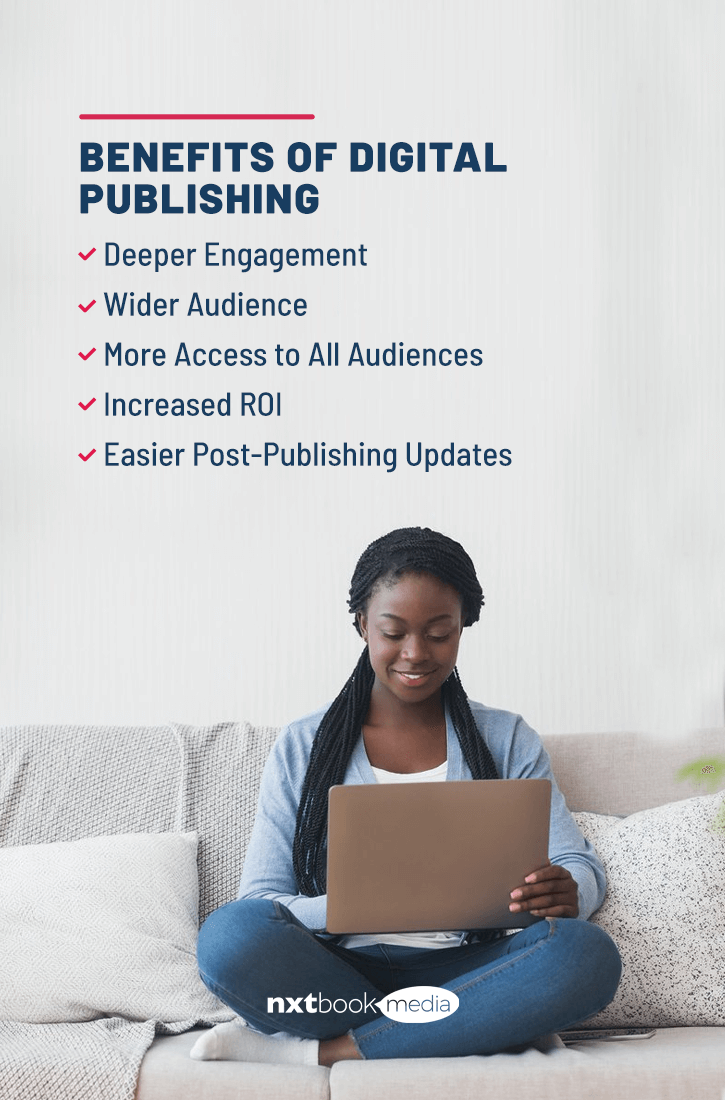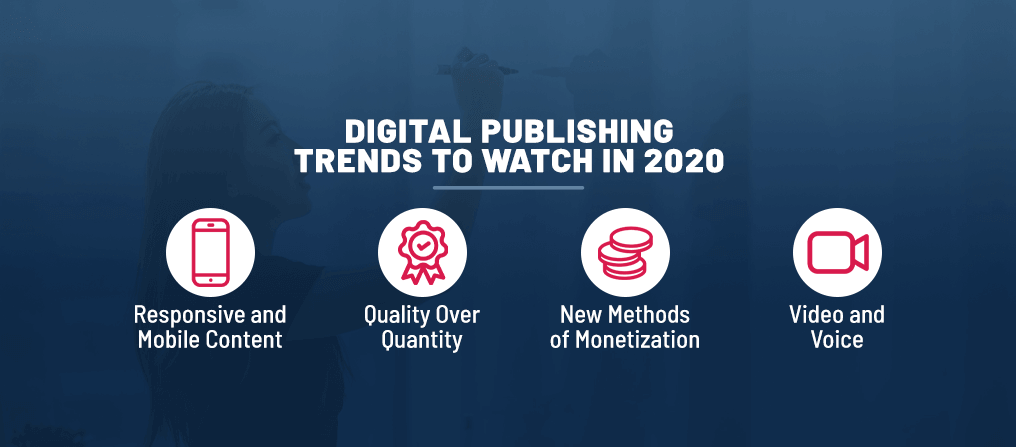Everything You Need to Know About Digital Publishing

Written by Matt Berringer
July 26, 2022
Updated July 26, 2022
Welcome to the world of digital publishing and online publishing platforms. For many, the first things that come to mind when they think of digital publishing are e-books and blogs. But you might be surprised at all the forms digital publishing and media can take. Since the start of digital publishing, it has grown exponentially and evolved into a form that is competitive with print publishing.
Here, we’ve put together an extensive guide on everything related to the topic, including the potential benefits, fact-based strategies, trends, online publishing approaches and our best recommendations on where to start.
Find what you’re looking for:
Getting Started – Publishing Trends – Monetization –
Content & Design – Audience Development –
Engagement – Publishing Tools –
Choosing a Platform – Industry Specific – Examples
(Or, email yourself the guide for later)
What is Digital Publishing?
In the broadest sense, digital publishing is the sharing of media on computers. To break down the meaning further, we can review the exact definitions of “digital” and “media” as follows:
- Digital: Digital refers to a vast category used to describe anything involving computers. Your laptop, cellphone, tablet and voice-activated devices are all examples of digital channels used to share media.
- Media: Media is any medium used to communicate a message, like the paper you use to write a letter or even the hieroglyphics found on Egyptian monuments. More specifically, digital media is a large category that includes books, pictures, video, music, audio, video games, mobile apps and so on.
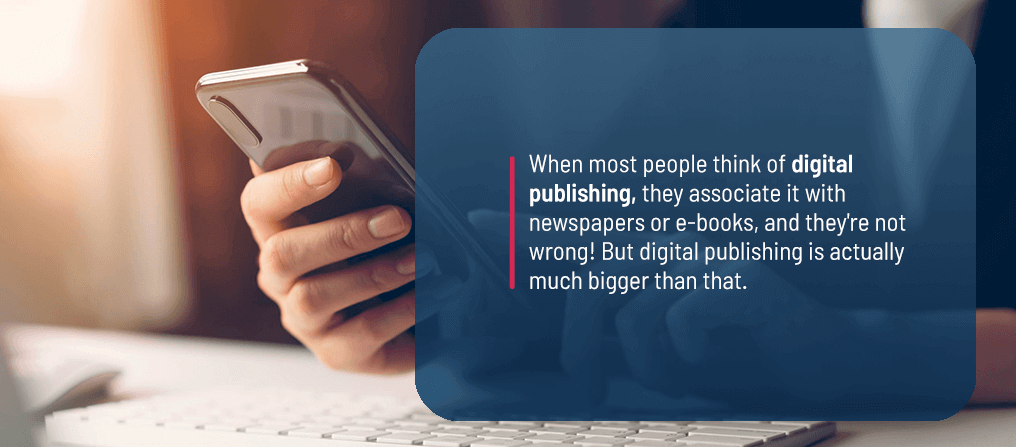
Examples of Digital Publishing
When most people think of digital publishing, they associate it with newspapers or e-books, and they’re not wrong! But digital publishing is actually much bigger than that. It’s the how-to videos you watch on YouTube, the apps you use to book movie tickets or the presentations you watch on TED Talks.
(See Digital Publishing Examples)
Benefits of Digital Publishing
Let’s talk about the news. How do you stay updated on presidential elections, the latest celebrity happenings or groundbreaking medical discoveries? If we asked you 30 years ago, the obvious answer would be through the newspaper. Now, you would probably answer that you get your news through morning TV broadcasts or mobile apps.
With 4.57 billion active internet users worldwide, there’s no denying the significant influence of technological advancements. People just are not relying as heavily on traditional publishing methods anymore. Most would agree, though, that this transition is a good thing!
If you want to transition to digital publishing, expect benefits like:
1. Deeper Engagement
For anyone sharing content, your goal is to keep your audience engaged as long as possible. Consumers are accustomed to tuning out the clutter of unrelated advertisements, ineffective pop-ups, complex site navigation and unreadable content.
Digital publishings eliminate clutter, providing a fine-tuned user experience that keeps them engaged and more responsive to your brand and calls-to-action (CTAs).
Comparatively, in a world of endless scrolling and updating social media feeds, users lack the sense of having finished something. Questions are left unanswered, valuable time is lost and people are stuck with the feeling of incompleteness.
Digital publishings resolve these feelings. The fine-tuned experience delivers a sense of completeness, with users receiving direct and engaging information through multimedia like enticing text, videos and infographics.
2. Wider Audience
Select distribution points limit traditional printing methods. Comparatively, digital publishing entices relevant consumers and is available to the billions of active internet users worldwide.
Digital publishings travel with users, too. As people rely more on technology and convenience, keeping your content mobile is a hugely influential factor for businesses to be aware of. As of 2021, there were just under 7 billion mobile users worldwide, projected to grow to 7.3 billion by 2023.
That’s a lot more people than the hundreds or thousands — or rarely millions — of people that traditional methods reach.
3. More Access to All Audiences
When moving online, stay mindful of the diversity of new people engaging with your content. Some of your audience might not see, hear, move, speak or understand as well as others — and that’s okay!
Digital publishing allows you to communicate information through different media to engage everyone, people with disabilities included. If your publications are typically text-based, diversify them by adding:
- Audio.
- Informational videos.
- Visualized graphics.
- Easy-to-use features.
- Enlarged graphics or text options.
Traditional print limits these choices, dismissing a large population who could benefit from your content.
4. Increased ROI
Traditionally publishing and printing content is expensive. Granted, creating and producing content of any kind comes at a cost, but digital publishing saves valuable money in the long run by:
- Diminishing print costs: Printing doesn’t come for free. The costs associated with printing and binding your content can reach the thousands, not to mention the hundreds or thousands spent printing your content during pre-publishing for proofing and processing.
- Reducing publication costs: As we mentioned, digital content entices customers to come to you. Marketing is integral in every publishing process but comes at a much higher expense with traditional publishing methods.
- Saving shipping costs: Unless your user purchases a hard copy of your publication, you won’t need to worry about shipping costs. Consumers already have a mobile copy they can take with them wherever and whenever they want to help them save space.
The more involved you are in digital publishing, the more results you will see. Because these results are online, you can track accurate data to see exactly where you’re saving money and which areas you can save more in.
5. Easier Post-Publishing Updates
Even the most practiced content creators make mistakes from time to time, which experienced editors might miss during proofing. It’s an inevitable part of publishing. When it happens, you want a way to easily and quickly fix it before your users form a potentially negative impression of your brand.
If you print and distribute your content, you can’t easily take those original prints back. By publishing your content digitally, you have continuous control of your publication, allowing you to quickly fix typos or factual errors and update it everywhere.
What Is a Digital Publishing Platform?
Creating engaging digital media is great, but where do you publish it to maximize its performance? Digital publishing platforms are tools where you can easily put your content online for consumers to access.
The right digital publishing platform brings your digital media to life. It makes your content available, boosts exposure to the most relevant audience and elevates your publication to create the user experience we just outlined. A digital publishing platform is a lifeline for your digital media.
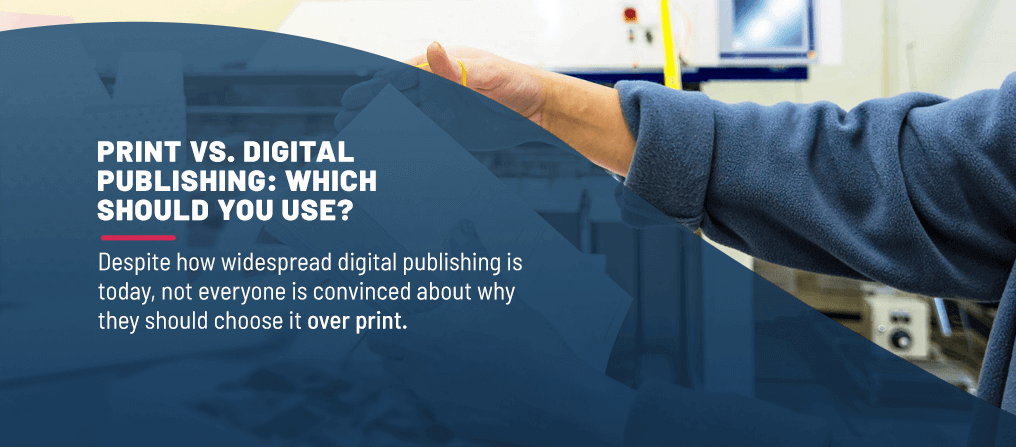
Print vs. Digital Publishing: Which Should You Use?
Despite how widespread digital publishing is today, not everyone is convinced about why they should choose it over print. This section can help you understand the numerous advantages of digital publishing — plus how it can even combine with print.
Why Transform Print to Digital?
To summarize the benefits of digital publishing, going digital with your content can:
- Deliver an engaging consumer experience.
- Put your content in front of more people.
- Accommodate a diverse audience.
- Save money while also making more revenue.
- Allow for easy updates.
But that does not completely diminish the benefits of print media. Attention-grabbing prints will always attract an audience, and nothing can replace the feeling of a vast home library with printed books and magazines.
The print and digital worlds aren’t drastically different. Because they overlap in many aspects, you can achieve impressive results by using both publishing strategies.
Using Print and Digital Together
To best explain the benefits of using both print and digital publishing strategies, let’s use an example. Assume you are a textbook publisher and, being aware of technology’s influence, you want to create a digitally interactive experience for students to engage with. Great!
Starting at ground one, make your textbook available both in print and digitally. Some students prefer taking a hard copy to class, while others prefer loading the textbook on their laptop or tablet. By implementing both channels, you have tailored to different working styles within your target demographic and saved money by scaling back printing costs.
To enhance the interactive experience, entice students with e-books to follow a link for practice exams, exclusive learning videos or real-life applications. For hard copy students, direct them to your mobile app or utilize tools like barcodes so they can engage in the same digital content.
Don’t limit yourself or restrict consumers with either print or digital content. Both influence buying decisions and enhance user engagement, so explore ways to use both strategies.
Is Digital Just for the Publishing Industry?
Absolutely not! Every business within all industries can take advantage of digital publishing, as everyone has a message to communicate. Even the most unique businesses, like kayaking equipment or gold-plated gardening tools, have a product to share and brand to build.
Digital publishing is breaking free of its outdated stigma of only text-based media like newspapers or e-books and branching into other media elements like mobile apps and video games. Even your business can benefit from digital publishing tools.
Industries Benefiting from the Print to Digital Transition
Some industries are tapping into the potential of digital publishing faster than others, including:
- Health care: Now more than ever, patients have direct access to electronic health records, mobile real-time monitoring technology and analytics through digital platforms for transformative health care services.
- Finance: Rarely do people want to dissect financial numbers. Digital publishing does the hard parts for audiences, encouraging more informed decisions and interaction with other business services.
- Tourism: When visiting new places, tourists have mobile access to maps, highly rated restaurants and destinations, safety information, plane tickets and any other necessary tools to keep their itineraries organized.
Digital books, magazines and newspapers generate over $22 billion in revenue worldwide. Imagine how much revenue digital publishing generates as industries incorporate digital media into their customer experience!
Digital Publishing Trends to Watch in 2022
As technology advances and new norms establish, the way consumers find and interact with your digital content will change. It’s an inevitable part of any digital marketing or publishing strategy. The best way to embrace these rapid changes is to stay flexible and knowledgeable on the trends. In 2022 and stemming into the near future, some of the top digital publishing trends to watch are:
1. Responsive and Mobile Content
In 2022, your content should be mobile-friendly and easy to use.
Consumers no longer interact with content solely on a desktop computer. Instead, people reach into their pockets for their mobile smartphones, typing their queries into search engines for a quick resolution.
Of the 96% of Americans that own a cellphone, an increasing majority — 81% up from 35% in 2011 — own a smartphone, and about half own tablets or e-readers. Without adjusting your content to accommodate these smaller mobile devices, consumers likely won’t be able to immerse themselves in your brand or respond to your offerings.
In fact, they’ll likely leave your site feeling frustrated after dealing with the complex navigation, often turning to a competitor for the desired information. Consumers value convenience. Put yourself in their shoes and deliver a mobile experience that is easy to read, fast to load and simple to navigate.
2. Quality Over Quantity
Posting fast “okay” content will not generate more results. Instead, share high-quality content routinely, predicting your audience’s questions and answering them definitively and accurately.
Have you ever been in a meeting that starts powerful and informative, but drags toward the end because of irrelevant or unnecessary details? Your audience will feel the same way toward frequent low-quality content and start to dread the next meeting.
Post content that brings something new to the conversation. Remember that your competitors are grasping for the audience’s attention too, so answer the question better than they can. By delivering consistent, high-quality content, you’re also developing a more loyal audience who trusts what you have to say.
Learn about content creation:
- Develop an Effective Content Marketing Plan
- Building a Content Calendar
- Content Experiences at Scale
- How to Create Responsive Digital Content
- How to Find Content
3. New Methods of Monetization
With so many people active online, you want to narrow down your audience. By segmenting your customer base and tailoring your monetary efforts to their specific wants and needs, you’ll likely see greater interaction rates and revenue.
Some 2022 methods of monetization are:
- Analytics software: Data analytics gives you an in-depth look into how your audience interacts with your content. Use this information to segment this larger audience into buyer personas and then tailor your content to fill any gaps or missed opportunities.
- Subscription model: Not new to 2022 but rapidly evolving, the subscription model is a tried-and-true monetization method. Linked to longevity and increased brand loyalty, subscription-based publishing allows your customers to segment themselves, choosing between different subscription levels where you can meet their unique needs.
- Advertisements: Accurate segmentation leads to more effective advertisement placements. People know when they’re being advertised to and try to reduce the screen clutter through adblocking software. If you conduct marketing strategies correctly, people will engage with advertisements at higher rates, generating more revenue for you.
As technology advances and consumer behavior changes, we’ll see shifts and additions to these methods. Above all, keep track of what your customers are doing and tailor to their lifestyles.
Learn more about monetization:
4. Video and Voice
Digital publishing extends far past text-based engagement. In 2022, we can expect a shift away from text and toward video and voice content.
Videos allow you to transform your content to maximize engagement and better communicate your brand’s image. From educational content to social media livestreams, people around the globe will increasingly rely on video. This content will generate multiplied traffic by 2023.
At an even steeper growth rate, digital voice assistants will largely change the way consumers interact with content. Currently, there are approximately 4.08 billion voice assistants worldwide, which is estimated to double by 2023. Instead of typing statuses on social media or questions into search engines, consumers will utilize home devices or smartphone voice features — a huge game-changer in digital publishing.
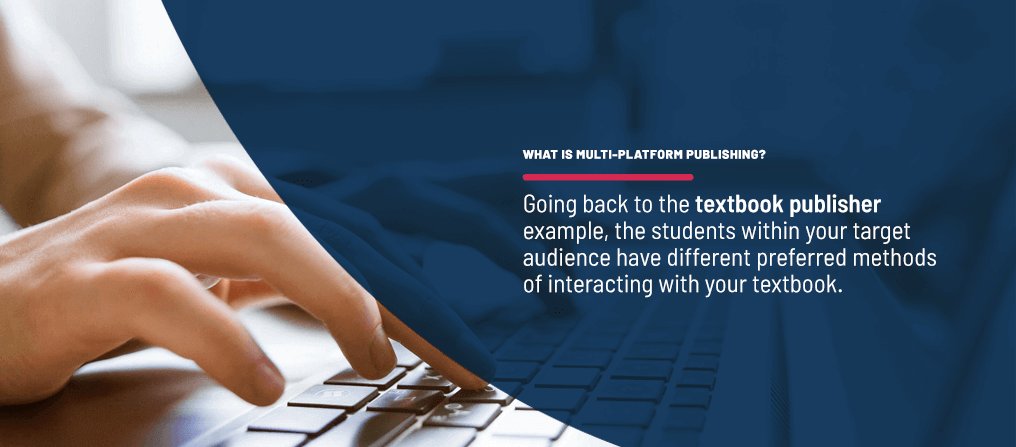
What Is Multi-Platform Publishing?
Multi-platform publishing is posting content, either the same or varying types, on multiple publishing platforms to reach more people. If you choose only one platform to publish your content, you’re putting all of your eggs in one basket.
Going back to the textbook publisher example, the students within your target audience have different preferred methods of interacting with your textbook. Similarly, consumers across all industries are guaranteed to have different preferences. By publishing on multiple platforms, you’re tailoring to those unique needs.
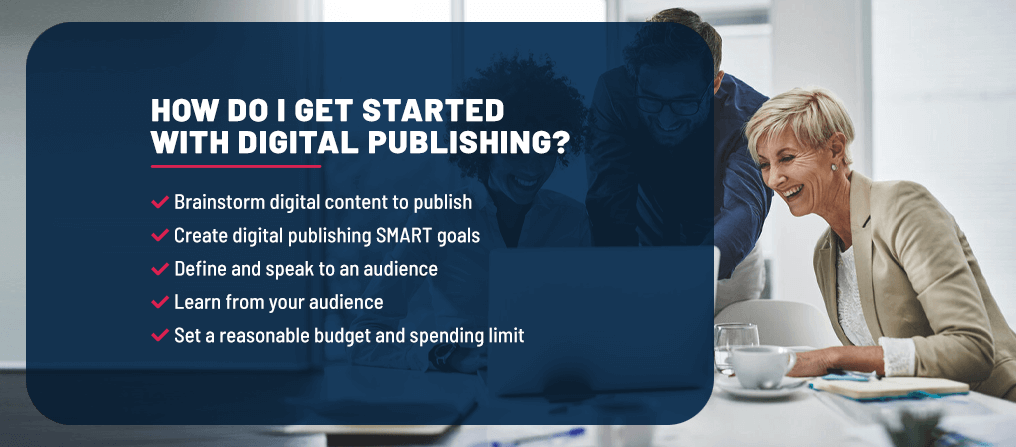
How Do I Get Started With Digital Publishing?
With digital publishing being a relatively new and quickly expanding strategy, it’s understandable not to know where to start. To get started with digital publishing, you should:
- Brainstorm digital content to publish: Regarding content, you have a lot of options. Take the time to review your content with your team, brainstorm what you’re already publishing that you can transform digitally and find gaps you can fill.
- Create digital publishing SMART goals: What are you trying to achieve with your content? Set measurable goals and track your progress post-publishing through built-in platform analytics.
- Define and speak to an audience: Avoid talking to the void. Determine who you’re talking to based on who would benefit the most from what you have to say.
- Learn from your audience: How do your users want to receive information? What are their lifestyles and values? Why should they engage with your content over a competitor’s? These are all things you want to consider when creating and publishing your digital content.
- Set a reasonable budget and spending limit: Find a comfortable balance between achieving your needs and staying within your budget. Some digital publishing software solutions and platforms come with a higher price tag and different levels of features, so keep that in mind when setting a budget.
Because of digital publishing’s fast growth, make sure you are keeping up with the trends and integrating a consistently competitive digital strategy.
For a more detailed step-by-step process on getting started with digital publishing, visit our 2021 digital publishing guide!
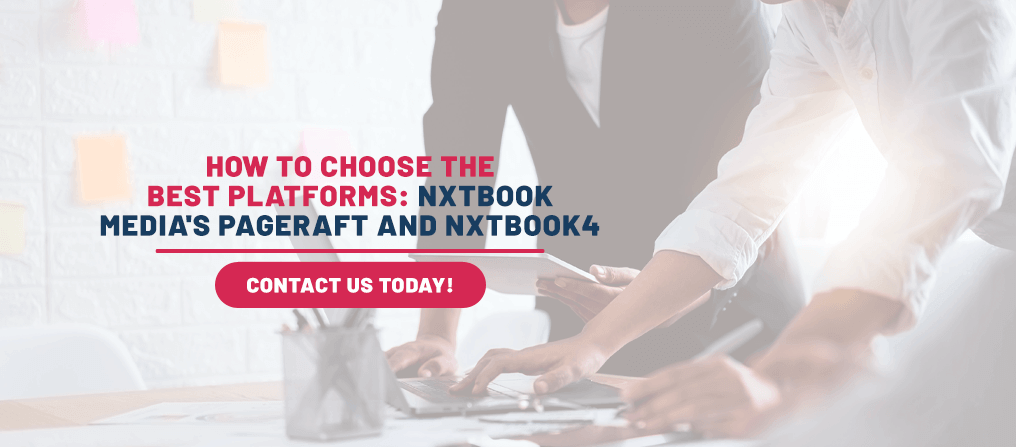
How to Choose the Best Platforms: Nxtbook Media’s PageRaft and nxtbook
Picking the right digital publishing platform largely depends on your unique goals. We want to help you meet these objectives and find the best fit for what you want to publish! At Nxtbook Media, we have a passion for inspiring others and encouraging them to keep pushing onward. Whether we’re working with our clients or serving the community, our goal is to make a positive impact that helps motivate others.
Since 2003, we have been proudly working with numerous companies, which has given us years of experience to help our clients reach their goals and make their digital programs successful. We are a small, privately owned business, which means we are easily accessible and can quickly address any situation you’re in.
With our two comprehensive digital publishing platforms, PageRaft and nxtbook, and your dedicated Partner Advocate Team, Nxtbook Media will help you keep up with the changing trends and maintain a satisfactory customer experience for your audience.
To get started on your digital publishing or learn more about how we can improve your current or new digital publishing program, schedule a demo and connect with our Partnership Development Team at Nxtbook Media today!
